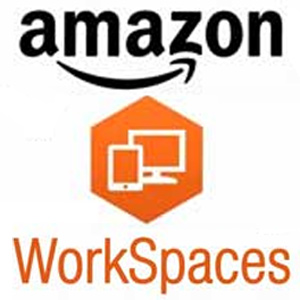 NEWS
NEWS
 NEWS
NEWS
 NEWS
NEWS
![]() Amazon Web Services (AWS) expanded its cloud services portfolio. After computing (EC2), storage (S3), database (RDS), application, content distribution, deployment and management, and billing, Amazon enters into desktop infrastructure virtual solution (VDI).
Amazon Web Services (AWS) expanded its cloud services portfolio. After computing (EC2), storage (S3), database (RDS), application, content distribution, deployment and management, and billing, Amazon enters into desktop infrastructure virtual solution (VDI).
During the recently concluded AWS re:Invent 2013 event, the e-commerce company launched Amazon Workspaces, a VDI solution for managing desktops in the cloud that is accessible from laptops, tablets, smartphone, etc. These desktops are basically Windows Server sessions that can be rented from Amazon $35 a month. WorkSpaces come pre-installed with Windows 7 desktop and has the ability to install any other software.
The cost of desktops available in the Amazon WorkSpaces represent less than half the cost of desktop virtualization built in the corporate data center. As part of the Amazon Workspaces, the platform will be made available in a fully managed Windows 7 in four different packages – Standard, Standard Plus, Performance and Performance Plus.
Amazon WorkSpaces support multiple devices so users can access their Amazon WorkSpaces using their choice of device, such as a laptop computer (Mac OS or Windows), iPad, Kindle Fire, or Android tablet. It provides each user with access to persistent storage in the AWS cloud and offers a choice of bundles providing different amounts of CPU, memory, and storage so you can match your Amazon WorkSpaces to your requirements. In addition, Amazon WorkSpaces securely integrates with corporate Active Directory so that users can continue using their existing enterprise credentials to seamlessly access company resources.
Virtualization powers DevOps
So, how does desktop virtualization solution like Amazon WorkSpaces help developers boost their efficiency? Amazon has effectively capitalized on the cloud and virtualization to enable developers to dematerialize their work environment. If they wish, they will be able to enjoy a session available online from any computer, which still cost them less than a real server.
Given the increased use of DevOps, VDI utilizes server hardware to run desktop operating systems and application software inside a virtual machine. Developers access these virtual desktops using their existing PCs. This not only eliminates the need for workstation hardware upgrades, but also enables developers to switch between operating environments. Desktop as a service will appeal to those who need pop-up-desktops for contractors or to quickly get projects started.
Developers, more so than most users, require fast machines. They need workstations, office networks, IDEs, debugging software, etc. VDI renders DevOps administrative and management lifecycle tasks much easier, because every attached workstation can use the same image. Install OS and application software updates, patches and required IDEs and debugging software to the one image, and every desktop system using that image is automatically updated and patched.
Storage performance also was a key factor in ensuring workstation speed. Because everything is cloud-based and persistent in WorkSpaces, the same data and same experience is carried forward wherever developer log in.
Virtualized workstations for Agile development
Integrating virtualization and agile techniques are the first steps towards utility computing, where data and computing power can be automatically moved through an IT infrastructure, when needed. It also improves system throughput and reliability by deploying computational power when necessary and also maximizes utilization of systems otherwise underutilized resources.
Amazon pitched its desktop-as-a-service offering as a more affordable approach to traditional VDI offered by Citrix, VMware and Microsoft. That’s because with WorkSpaces, IT can spin up virtual desktops without buying hardware or software just as they can with Amazon’s cloud and storage portfolio of services.
“Amazon really can have a significant impact on this and they’re a real player in this space now…” said Stu Miniman about Amazon Workspaces on TheCube.
For developers, companies can use customize WorkSpaces to provide a range of target environments for development and testing (such as different operating systems, OS versions and browsers), and also to provision/re-provision configuration instances quickly and easily.
The agile development contains short iterations, and each iteration ends with test certification. Time for setting up test machines can be saved by using shared operating system instances, since it provides the benefit of installing software on a global system and makes it available on all shared operating instances with minimal effort.
John Furrier added that the real space that people expect VDI to grab attention is not on desktops but on mobile platforms and Dave Vellante said, “Remember when, Compaq dominated the PC business, and Dell came late to the game, but they came with a better model. Dell became a dominant player and disrupted, I feel like the timing is right for Amazon, they’re architecting around mobile… I feel like a lot of people will glom onto this.”
Support our open free content by sharing and engaging with our content and community.
Where Technology Leaders Connect, Share Intelligence & Create Opportunities
SiliconANGLE Media is a recognized leader in digital media innovation serving innovative audiences and brands, bringing together cutting-edge technology, influential content, strategic insights and real-time audience engagement. As the parent company of SiliconANGLE, theCUBE Network, theCUBE Research, CUBE365, theCUBE AI and theCUBE SuperStudios — such as those established in Silicon Valley and the New York Stock Exchange (NYSE) — SiliconANGLE Media operates at the intersection of media, technology, and AI. .
Founded by tech visionaries John Furrier and Dave Vellante, SiliconANGLE Media has built a powerful ecosystem of industry-leading digital media brands, with a reach of 15+ million elite tech professionals. The company’s new, proprietary theCUBE AI Video cloud is breaking ground in audience interaction, leveraging theCUBEai.com neural network to help technology companies make data-driven decisions and stay at the forefront of industry conversations.